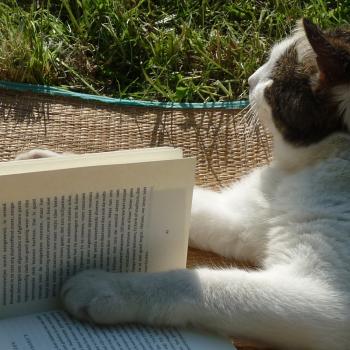Post title via Don Colacho.
Best books read for the first time (non-fiction): Rebecca Lemon, Addiction and Devotion in Early Modern England. Ever feel like somebody wrote a book just for you?
Sigrid Undset, Catherine of Siena. Toons for our times.
Colin Ward, The Child in the City. The child as anarchist is also the child as traditionalist.
Ray Huang, 1587, A Year of No Significance: The Ming Dynasty in Decline. A recommendation from Will Wilson after I asked him to pick something random for me to read. I know essentially nothing about Chinese history and loved this evocative portrait of the economic, political, and personal factors leading to a great dynasty’s downfall. If you know nothing about the setting it reads like science fiction/fantasy, full of court intrigue and family politics.
John Braithwaite, Crime, Shame, and Reintegration. One of the founding works of scholarship for “restorative justice” and highlights some of that movement’s characteristic flaws (e.g. theorizing as if all defendants are guilty and all crimes should be outlawed) as well as its many strengths. I underlined big chunks of this book. Humiliation and shame seem to be themes this year. Well, we all deserve it.
Francesca Polletta, Freedom Is an Endless Meeting: Democracy in American Social Movements. I’m letting myself add a sixth book to this top five in order to give you this practical history of several forms of “participatory democracy.” Polletta argues that social movements which wanted to use participatory democracy modeled their practices and self-concepts on better-known relationships–the polity as family, the polity as church–and inherited the characteristic conflicts of these models as well as their characteristic strengths. She also depicts quite movingly the way that the practices of participatory democracy brought into leadership people, like sharecroppers in the segregated South, who had been told they were too uneducated to share decisionmaking with their betters. The group portraits in this book reminded me of everything from Riot Grrrl to my college right-wing debating society; and I’m still thinking about how to participate in gay Christian ministry in a way that fosters leadership among those who have often been shamed into silence. I loved this and it was a vivid read, full of, as Alice would say, pictures and conversations. (The pictures themselves often told a story, as with the civil-rights workers standing, arm in arm, to sing at the close of a meeting. How can anyone organize without beauty–and why would you?) ETA: I found out about this book via PrisonCulture.
Also notable: Juliet Ash’s Dress Behind Bars: Prison Clothing as Criminality is not a well-written book, but it made several interesting points I hadn’t seen elsewhere, e.g. the egalitarian origins of the prison uniform. Similarly, Martha Duncan’s Romantic Outlaws, Beloved Prisons: The Unconscious Meanings of Crime and Punishment would be a mixed bag even if it weren’t Freudian (for real! in the year of our Lord 1996! bless.), but the chapters on people’s positive memories of prison and the excrement metaphor in prison policy were both good and interesting work.
Best books read for the first time (real books): Giuseppe di Lampedusa, The Leopard. tr Archibald Colquhoun. As if thirst and remorse are the only human emotions.
Joseph Roth, The Radetzky March. tr Michael Hoffman. This is a world where everybody you see all day, from the porters to the postmen, works for His Majesty, and parents think of their children by their military titles.
Mikhail Bulgakov, White Guard. tr Marian Schwartz. Bulgakov wrote in a 1923 essay, “By the account of the Kievans, they’ve had eighteen coups,” although he could only vouch for “fourteen, ten of which I personally experienced.”
Junichiro Tanizaki, Naomi. tr Anthony Chambers. I suppose if humiliation is our theme then a sleazy tale of sexual humiliation is a necessity.
Also notable (listed in the order in which I read them): Gabriel Blanchard, Death’s Dream Kingdom; Barry Unsworth, Morality Play; Italo Calvino, Invisible Cities; Dorothy Gilman, The Tightrope Walker; Andrzej Szczypiorski, A Mass for Arras; Catherynne Valente, Space Opera.
Best movies watched for the first time: Doing a top ten this year instead of a top five, mainly to emphasize how good The Favourite was.
Salò, or the 120 Days of Sodom. The best movie I saw this year. I asked myself, “Are you just saying that to be edgy?” but no, this famously-unwatchable film pretty much overwhelmed me. I’ll be writing about it in the new year, so if you are an editor who for some reason wants an essay about Salo, hit me up. Note that this film’s #1 placement on my list is not a recommendation that you watch it.
Jeanette. If Vatican City entered the Eurovision Song Contest….
The Song of Bernadette. I thought my somewhat clickbaity essay on this wonderful, touching, liberating movie turned out well. Here’s more meditation on the nature and spirituality of humiliation; in this case, a startlingly subtle reflection on both the beauty of humiliation and the ways it can serve injustice.
Weiner. Good grief, everything on this list really is about public humiliation.
The Flowers of St. Francis. See?
Also notable (in roughly the order in which I watched them): The Texas Chain Saw Massacre, Clash, In My Skin, The Death of Stalin, Oculus, Ushpizin, Cotton Comes to Harlem, Dos Monjes (Two Monks), Eaten Alive, La Otra (The Other), Valerie and Her Week of Wonders, Nosferatu: Phantom der Nacht, Born in Flames, Summer Hours, Titicut Follies, Coriolanus (2011), Still Walking, Ms. 45, Johnny Guitar, Sneakers, The Prince of Egypt, C.H.U.D., The Wolf House, The Lords of Chaos, Into Great Silence, The Rapture, Ladyhawke, Planet of Snail, A Woman Under the Influence.
Best articles by other people: This category is always so scattershot because I forget stuff. And focusing on one excellent article risks ignoring someone like Dara Lind, who has been doing consistently strong reporting on a beat (immigration) which could not be more difficult or necessary.
Two of the best short pieces I read this year were Catherine Addington’s newsletters: on indigenous nuns, and on better hagiographies of Bl. Laura Vicuña. I also really enjoyed her piece on the limited imagination of the Met Gala.
I enjoyed Matthew Schmitz’s irresponsible, highly pleasurable use of Grace Kelly and Rita Hayworth as avatars of two kinds of American Catholicism.
Here are two moving pieces about the lives and worth of lost people: a NY Times piece on Los Angeles’s yearly ceremony for honoring the unclaimed dead; and a long exploration of the men who minister to members of MS-13.
This piece by Martyn Jones on Jim and Tammy Faye stuck with me. (Speaking of media and humiliation, of which more anon.)
Finally, here are two personal essays I’m sure will appear on many people’s best-of lists, entirely rightly: B.D. McClay’s “Why I Came” (into the Catholic Church), and Helen Andrews’s “Shame Storm” (on being one of the first to experience online “viral” shaming). They’re both taut, both pieces I do not think the authors much wanted to write. And they are both, in part, about the ways in which it doesn’t matter what we deserve. This is something many readers of Andrews’s piece have missed. They’ve wanted to parse out the guilt, the just deserts, of the many shamed people she named, and point out that some of them were really asking for it. But her essay is specifically about aspects of the online-shame experience which do not depend on what you deserve, or how much of it.
Similarly, some readers had trouble comprehending the way Andrews condemns the “shame storm” outright but also says it did “redemptive” work in bringing the humility which can be born of humiliation. That whole dynamic reminded me of this harrowing piece about people who were filmed while overdosing, whose “overdose videos” went viral. “This was cruel, humiliating, and (therefore) wrong, and it could have destroyed me, but instead it probably saved my life” is not an assessment we accept easily–people want to justify the humiliation because of the outcome. But that’s utilitarianism. God can bring good out of evil, but do not do evil that good may come of it. At any rate, that overdose-videos piece is also very much worth reading.
And I’ll stick this here: I rarely read short stories in magazines; and for reasons that are unclear to me, these days I rarely read science fiction. Sarah Pinsker’s “And Then There Were (N – One)” was brilliant–a murder mystery set in a collision of alternate realities. Clever; but also a story about the worth of a life which even the person living it may not consider to be worth much. Found via Rachel Brown.
Best articles by me: My long piece on ministry to corrections officers has an unpleasantly utilitarian structure, and isn’t the best piece on this subject which could be written; but, well, nobody else was doing it so I did it.
I thought my review of Michelle Tea’s Against Memoir turned out well–about feminism and humility. Ditto my review of Martin Duberman’s Jews Queers Germans, which, uh, did what it said on the tin. “Many more rules will soon be broken.”
Here’s a cri de coeur about the bad advice embedded in the concept of the “success sequence.”
“A Painting Reveals the Heart of Penance.” On Bernard of Clairvaux, and penance as intimacy with Christ.
Best blog posts by me: I never found a publisher for a long essay on reactionary novels, in part because I never figured out a good ending. (Just like the last century, n’est-ce pas?) But along the way to its insufficient ending I think I made some interesting points about The Leopard, White Guard, The Radetzky March, The Glass Bead Game, and Sword of Honour. ETA: Oh hey, it may have found a publisher, so I’m taking it down. My apologies but the published version should have some sort of real ending…. We’ll see.
Here’s a disorganized series of reflections on re-reading St. Anselm’s Cur Deus Homo, twenty years after it helped provoke my conversion.
My series on Peter Brown’s Body and Society was a mixed bag, but I thought “Damned to Pixar Heaven,” the post about celibate ecstasy, “Blessed Are the Sleazoids,” and “The Slave as Temple” turned out well.
I’m the wrong person to assess this piece about what (or who) the Catholic Church is, in a time of abuse and cover-up by Church leaders. But it’s still basically what I believe.
Piece by me that I’m least satisfied with: Maybe that John Bellairs essay. He deserved better from me.
Best anthology edited by me: Christ’s Body, Christ’s Wounds: Staying Catholic When You’ve Been Hurt in the Church. Working on this book reshaped my own faith in certain ways. Several pieces here explore the difficult process of learning that God is not your abuser, and does not speak with that person’s voice.
Best novel for which I’m currently seeking an agent/publisher: still Voluntary Compliance. Get in on the ground floor of this weird thing.
Best conference for gay people who accept the historic Christian sexual ethic: Revoice! Revoice would win this category even if it weren’t the only conference of its kind. I hope to see many of you all in St. Louis this summer. This has been such a wonderful development for our emerging community.
Most human heart venerated by me in 2018: the Sacred Heart of Jesus (lol not that I actually had any special devotion to the Sacred Heart this year but you’ve gotta show respect). Second-most human heart venerated by me in 2018: St. John Vianney’s. In a year when we are all learning yet again that every reform and new rule can become simply an obstacle to be worked around or even a tool to be exploited, it’s especially necessary to rededicate our own hearts to Christ; and ask that our stony hearts of complicity, cover-up, excuses, entanglements, secrets be removed and replaced with hearts of flesh.
Image of stained glass in All Saints Catholic Church, St Peters, Missouri via Wikimedia Commons.












